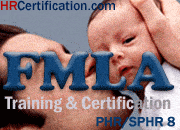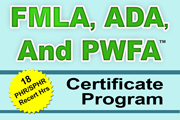
How to Write Effective Leave Policies
10/26/2025A clear, well-written leave policy does more than spell out who gets time off—it protects your organization and sets fair expectations for everyone. A strong policy is the foundation of a legally sound and compassionate leave management program. Whether you’re building a new HR handbook or updating your current one, this guide breaks down how to write effective leave policies that align with the FMLA, ADA, and state laws. You’ll learn what to include, how to document decisions, and how to make your policy both compliant and easy to understand.
Why Your Leave Policy Matters More Than You Think
A comprehensive leave policy is one of the most critical documents in your HR toolkit. It serves as a single source of truth that prevents inconsistent, ad-hoc decisions that can lead to discrimination claims and legal risk. For employees, it provides clarity and builds trust during what is often a stressful time in their lives. They know their rights, understand the process, and feel confident that they are being treated fairly.
From a compliance standpoint, your policy is your first line of defense. It demonstrates that your organization understands its obligations under a complex web of federal, state, and local laws. It also gives HR professionals and managers a reliable reference guide, empowering them to handle leave requests consistently and correctly.
Step 1 — Understand the Laws That Shape Your Leave Policy
Your leave policy does not exist in a vacuum. It must be built on a solid foundation of legal compliance, integrating the requirements of several key laws.
FMLA — Job Protection and Medical Certification
The Family and Medical Leave Act (FMLA) is the cornerstone of unpaid, job-protected leave. Your policy must incorporate its key provisions, including definitions of an eligible employee, a covered employer, and what constitutes a "serious health condition." The policy should explicitly state the employee's right to 12 weeks of leave, continuation of health benefits, and reinstatement to the same or an equivalent position. It also needs to detail the medical certification process, explaining the timelines for submitting documentation and the company’s right to request clarification or a second opinion.
ADA — Reasonable Accommodation and Extended Leave
The Americans with Disabilities Act (ADA) requires employers to provide reasonable accommodations for qualified individuals with disabilities. Leave can be a powerful form of accommodation. Your policy must make it clear that the organization will consider providing unpaid leave as an accommodation, even after an employee has exhausted their FMLA entitlement. It's crucial to outline the interactive process—the collaborative dialogue between HR and the employee to identify an effective accommodation. The policy should also mention that the duty to provide leave is limited by "undue hardship," and it should lay out a framework for how the company will assess such a hardship on a case-by-case basis.
PWFA and State Leave Laws
The Pregnant Workers Fairness Act (PWFA) mandates reasonable accommodations for limitations related to pregnancy, childbirth, or related conditions. Your policy must reflect this, clarifying that accommodations—which may include modified duties, schedule changes, or leave—will be provided. Additionally, your policy must account for the growing number of state and local leave laws. This includes paid sick leave mandates, paid family and medical leave (PFML) insurance programs, and other specific leave entitlements. The policy should state that it runs concurrently with any applicable state laws and that employees will receive the greater benefit or protection offered.
Step 2 — Define the Scope of Your Leave Policy
Once you've established the legal framework, you need to define who and what your policy covers. This section sets clear boundaries and helps employees understand how different benefits and leave types interact.
Who’s Covered
Be specific about which employees are covered by different parts of your policy. While federal laws like FMLA have specific eligibility criteria (e.g., 12 months of service and 1,250 hours worked), your company may offer other types of leave, like personal or bereavement leave, to a broader group of employees. Clearly define eligibility for full-time, part-time, temporary, and contract staff for each leave type you offer.
What Types of Leave Are Included
Your policy should be a comprehensive guide to all leave types available at your organization. Create distinct sections or clear definitions for:
- Family and Medical Leave (FMLA)
- Disability and Accommodation Leave (ADA)
- Pregnancy-Related Leave (PWFA)
- Military Leave (USERRA)
- Jury Duty and Witness Leave
- Bereavement Leave
- Personal Leave of Absence
Coordination With Other Benefits
This section is critical for preventing confusion. Explain how leave coordinates with other benefits and pay sources. Clarify that FMLA is unpaid but that the company requires employees to use accrued paid time off (PTO) concurrently. Detail how short-term disability (STD) or Workers’ Compensation wage-replacement benefits interact with FMLA leave and PTO. Your policy should also explicitly state that group health benefits will continue during FMLA leave under the same terms as if the employee were actively working.
Step 3 — Write Clear Procedures for Requesting and Managing Leave
A good policy outlines not just the "what" but also the "how." Employees and managers need a clear, step-by-step process to follow.
Leave Request Procedures
Detail the exact process for requesting leave. Specify that employees should provide notice to both their manager and HR as soon as practicable. For foreseeable leave, you can require 30 days' notice. For unforeseeable leave, it should be as soon as possible. Your policy should reference the official leave request form and explain where to find it. Make it clear that failure to follow the procedure may result in a delay or denial of leave.
Medical Certifications and Documentation
This section needs to balance the company’s need for information with the employee’s privacy rights. State that a medical certification will be required to support a request for FMLA leave. Explain what constitutes a complete certification and the timeline for submitting it (typically 15 calendar days). Crucially, you must include language that adheres to the Genetic Information Nondiscrimination Act (GINA). A "safe harbor" statement should be included on all requests for medical information, instructing healthcare providers not to share genetic information.
Tracking Leave and Intermittent Time Off
Your policy should explain how leave is tracked. For intermittent FMLA leave, you must describe the procedure for reporting absences. For example, you might require employees to call a specific attendance line and report that the absence is for their FMLA-approved condition. If you use leave tracking software, reference it here and explain the employee's responsibility for logging their time off correctly.
Step 4 — Clarify Pay, Benefits, and Job Protection
This is one of the most important sections for employees. Use plain language to explain how their pay, benefits, and job security are handled during leave.
State clearly that FMLA leave is unpaid. Then, explain your policy on concurrent use of paid time off. For example: "Employees are required to use any available accrued paid time off, including vacation and sick time, concurrently with FMLA leave. Once all paid time off is exhausted, the remainder of the leave will be unpaid."
Explain that health benefits will continue and detail how the employee's share of the premium will be paid. Also, clarify the status of other benefits. Does PTO continue to accrue during leave? Does seniority freeze? Be explicit.
Finally, outline job protection rights. Explain that under the FMLA, the employee will be reinstated to the same or a virtually identical position. Mention that under the ADA, the right is generally to the original position, with or without accommodation, and that the company will adhere to the stricter standard when laws overlap.
Step 5 — Include Return-to-Work and Reassignment Language
A successful leave process includes a plan for the employee’s return. Your policy should outline the steps for a smooth transition back to work.
Specify if a fitness-for-duty certification is required before returning from a leave for the employee's own serious health condition. Your return-to-work policy should also address accommodations. Explain that the company will work with employees who are returning with medical restrictions to provide reasonable accommodations, such as a modified schedule or adjusted duties.
Sometimes, an employee cannot return to their original job, even with accommodations. Your policy should address this by outlining your ADA reassignment procedure. Explain that if an employee is unable to perform the essential functions of their original role, the company will attempt to reassign them to a vacant, equivalent position for which they are qualified, as an accommodation of last resort.
Step 6 — Add Confidentiality and Recordkeeping Provisions
Reinforce your commitment to employee privacy and outline your compliance with legal recordkeeping requirements. State that all medical information, including certifications and doctor's notes, will be maintained in a secure, confidential medical file separate from the employee's main personnel file.
Specify that access to these files is strictly limited to designated HR personnel. Managers and supervisors will not have access to an employee's diagnosis or medical history; they will only be informed of necessary work restrictions and accommodations. Be sure to include your GINA safe-harbor language here as well, demonstrating your proactive approach to compliance.
Step 7 — Write in Plain Language
Legal compliance does not require dense legalese. An effective policy is one that employees and managers can actually understand and apply.
- Use simple, direct sentences. Instead of "The organization shall require," write "The company will require" or "You must."
- Avoid jargon. When you must use a legal term like "serious health condition" or "reasonable accommodation," provide a simple definition or an example.
- Use examples. For complex topics like intermittent leave, a short, practical example can provide more clarity than a paragraph of technical explanation.
Step 8 — Train Managers and Review Annually
A policy is useless if it sits on a shelf. Your policy document should reference a commitment to training and regular review. State that all managers will be trained on their roles and responsibilities in administering the leave policy. This training should emphasize recognizing a leave request and escalating it to HR immediately.
Furthermore, commit to an annual review of the policy. Laws change, and your policy must evolve with them. An annual audit ensures your procedures remain compliant with new regulations like the PWFA and emerging state-level paid leave programs.
Common Mistakes in Leave Policy Writing
- Copying and Pasting: Borrowing a policy from another company without adapting it to your workforce, culture, and specific state laws is a recipe for disaster.
- Forgetting ADA and PWFA: Many policies focus heavily on FMLA but fail to adequately integrate the company's separate duties to provide reasonable accommodation under the ADA and PWFA.
- Omitting Key Sections: A policy that lacks clear language on confidentiality, return-to-work, or reassignment leaves the company exposed and employees confused.
- Using Outdated Forms: Referencing or using old FMLA certification forms that are no longer compliant is a common and easily avoidable error.
Final Checklist: What Every Effective Leave Policy Should Include
- Legal Framework: Clear references to FMLA, ADA, PWFA, GINA, and applicable state laws.
- Procedures: A step-by-step process for requesting, documenting, and approving leave.
- Pay and Benefits: A clear explanation of how pay, PTO, and benefits are handled during leave.
- Confidentiality: A strong statement on medical confidentiality and recordkeeping.
- Return to Work: Guidance on reinstatement, accommodations, and reassignment.
- Review and Training: A commitment to annual updates and manager training.
Ready to Update Your Policy?
A strong leave policy protects both your organization and your employees. It is a vital tool for ensuring fairness, consistency, and legal compliance. Use our leave policy template and checklist to build a compliant, practical, and easy-to-follow policy that fits your workplace.







